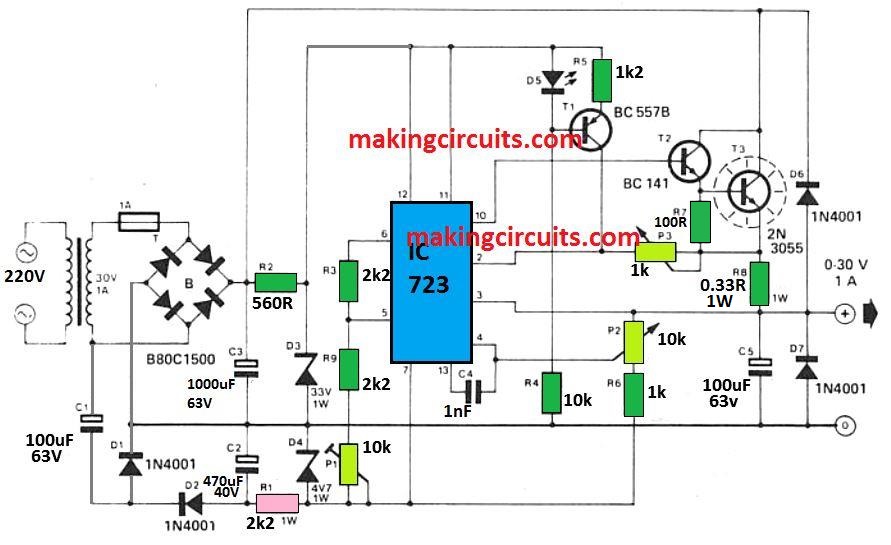This 0 - 30 V regulated work bench power supply provides outstanding line and load regulation and a continuously variable output from 0 to 30 V with output currents as much as one amp. The output features current limiting and is also protection against reverse voltage or over-voltage placed on the output terminals.
Circuit Description
The circuit is centered around the popular 723 IC regulator. As visitors who may have implemented this IC will be aware, the lowest output voltage typically accessible from this chip is + 2 V in accordance with the V - terminal of the IC (that is generally attached to 0 V).

The issue could be corrected by joining the V - pin with a minimum negative potential of around - 2 V, in order that the output voltage may drop down to +2 V in accordance with this, i.e. to zero volts.
To refrain from using a transformer having many secondary windings, the additional negative supply is acquired through a voltage doubler set up containing C1, C2, D1 and D2 and is regulated at -4.7 V through R1 and D4.
The utilization of - 4.7 V instead of -2 V signifies that the differential amplifier inside the IC 723 continues to work nicely using its common-mode range regardless if the output voltage is zero.
The primary positive supply voltage is extracted from the transformer by means of bridge rectifier B1 and reservoir capacitor C3. The source to the IC 723 is stabilized at 33 V by means of D3 in order to avoid its highest supply spec becoming maxed and a Darlington pair T2/T3 enhances the output current functionality to 1 A.
The current limit is consistently adjustable through P3. The output voltage could be tweaked through P2, although preset P1 can be used to get zero output voltage. The input supply is guarded against reverse polarity being utilized to the output wires by means of D7, and to resist over voltages as much as 63 V by D6.
To pre adjust the output voltage to zero, P2 is initially flipped anticlockwise (wiper rotated in the direction of R8) and P1 is after that tweaked until the output voltage becomes zero.
Having P2 moved totally clockwise the output voltage must subsequently be around 30 V. In case, on account of component limitations, the optimum output is seen lower than 30 V the R6 value might need minor lowering.
While building the 0 - 30V regulated power supply circuit, specific attention must be implemented to guarantee that the 0 V line is of minimal resistance (large SWG cord or broad PCB track) as voltage falls alongside this power rail could potentially cause bad regulation and ripple on the output.
it works pretty good
thank you
Hello.Is the current setting so? Short circuit on the output and then I adjust the current.The LED D5 will turn on when I will reach the adjusted current.
Thank you for the answear.
Hey Jan, I don’t think the LED indicates the current limiting status. I guess the D5 with T1 is used to supply a constant current reference to the IC.